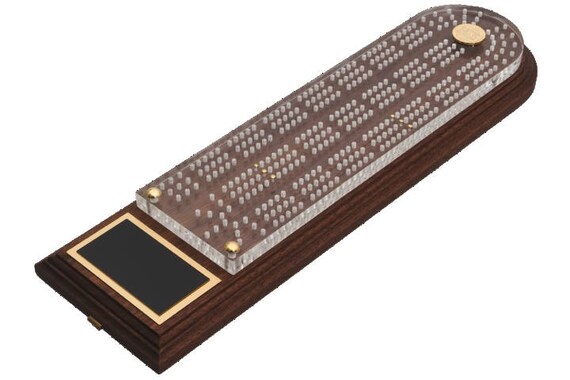Online Cribbage Board. Move: Drag & drop a back peg, or click the green buttons below. Undo/Redo: Click the / buttons, or use Ctrl / ⌘ + Z / Y. Edit Names: Click the names and enter new ones. Apr 5, 2015 - Free cribbage board templates Cribbage Corner (for printable rules go to: www.math.ucsd.edu/aniederm/cribbage.pdf). Cribbage is traditionally played with two players, but there are variations with three or four players. The game uses a deck of 52 cards. Each of the players has two pegs that are placed on the board. The pegs start at the end of the board and are used to mark the players' scores during the game. Toll Free: 1-877-MUGGINS (877-684-4467) E-Mail: muggins@cribbagesupply.com CribbageSupply.com 13618 County Road 748 Rosharon, Texas 77583 Cribbage Boards. These awesome Cribbage Boards take on the shape and dimension of a Stadium. The track sits up on tiered levels just like the seating at an arena. A great addition for the Sports fan Crib player or something else. We’ve done all types of sports teams from many different sports and we’ve even engraved a family crest into centre ice for a.
The California Rural Indian Health Board, Inc. (CRIHB) is committed to the needs and interests that elevate and promote the health status and social conditions of the Indian people of California. CRIHB does this by providing advocacy, shared resources, training, and technical assistance that enhances the delivery of quality comprehensive health-related services.
CRIHB Membership
Learn what CRIHB can do for you
Training Opportunities
For Members & Non-Members
Funding Opportunities
View Open Funding Opportunities
Contracting Opportunities
View Requests for Proposals
About CRIHB
The California Rural Indian Health Board, Inc. (CRIHB) was formed to provide a central focal point in the Indian health field in California for planning, advocacy, funding, training, technical assistance, coordination, fund raising, education, development and for the purpose of promoting unity and formulating common policy on Indian health care issues.
- Dental Transformation Initiative (DTI)
- Emergency Prepardness Resources
- Health & Wellness (ACORNS)
- HIV/AIDS Education
- Injury Prevention
- Nutrition & Diabetes
- Public Health Accreditation
- Public Health Nursing
- Suicide Prevention
- Tobacco & Cancer
Statewide Programs
California Tribal Epidemiology Center

CTEC is 1 of 12 Indian Health Service (IHS) Division of Epidemiology and Disease Prevention-funded Tribal Epidemiology Centers that provide epidemiologic support to each IHS region and often partner with local IHS area offices to provide these services.

.
California Tribal Medi-Cal Administrative Activities (TMAA)
The CTMAA Program offers a way for Tribal Health Programs to obtain federal reimbursement for the cost of certain administrative activities necessary for the proper and efficient administration of the Medi-Cal program.
Dental Support Center


California Dental Support Center provides technical assistance and resources to 36 Tribal and urban health programs (107 Tribes), which operate 58 dental clinics, in the state of California.
Advancing California Opportunities to Renew Native Health Systems
Cribbage Board
The CRIHB Advancing California Opportunities to Renew Native health Systems (ACORNS) is a CDC Good Health and Wellness in Indian Country-funded project.
CRIHB Options
CRIHB Options is a demonstration program, operating under California’s section 1115 Waiver amendment, entitled “California Medi-Cal 2020 Demonstration,” designed to reimburse participating Tribal Health Programs for certain Medi-Cal Optional Benefit services provided to IHS eligible Medi-Cal beneficiaries.
OUR MEMBERS
 For all three difficulty levels the cards are dealt completely at random to both you and to the computer. The difference between the easy, standard and pro levels is the strategy used to choose the computer's discards and pegging plays. If you are finding that your computer opponent is beating you, you will likely benefit from understanding how the computer chooses its next move.
For all three difficulty levels the cards are dealt completely at random to both you and to the computer. The difference between the easy, standard and pro levels is the strategy used to choose the computer's discards and pegging plays. If you are finding that your computer opponent is beating you, you will likely benefit from understanding how the computer chooses its next move. Crib Board Game
| Discarding: | Chooses a random pair of cards. |
| Pegging: | Chooses a random valid card. |
Cross Crib Board Game
| Discarding: | Chooses the pair of cards that will result in the best hand score ignoring the possible flip card. If the discards are a pair or sum to 15, it adjusts the analyzed hand value by 2 (plus or minus depending on the crib owner.) Notice that this strategy does not account for flushes or possible runs that could result from the flip card. |
| Pegging: | Chooses the next card that will result in the highest score for itself. If all plays are of equal value then it chooses at random. |
Crib Board Out Of Antlers
Cribbage Boards For Sale Custom
| Discarding: | Evaluates the score for each pair of discards for all possible flip cards still left in the deck. Then takes the play that averages the highest outcome. For the cards in the crib, evaluates their value as well with each possible flip card and adds or subtracts depending on who will count the crib. Note that the potential from the two additional crib cards are not included in the crib analysis. |
| Pegging: | Chooses the next card that will result in the highest score for itself. It also prefers not to leave the pegging count at 5 or 21. If all plays are of equal value then it chooses at random. |